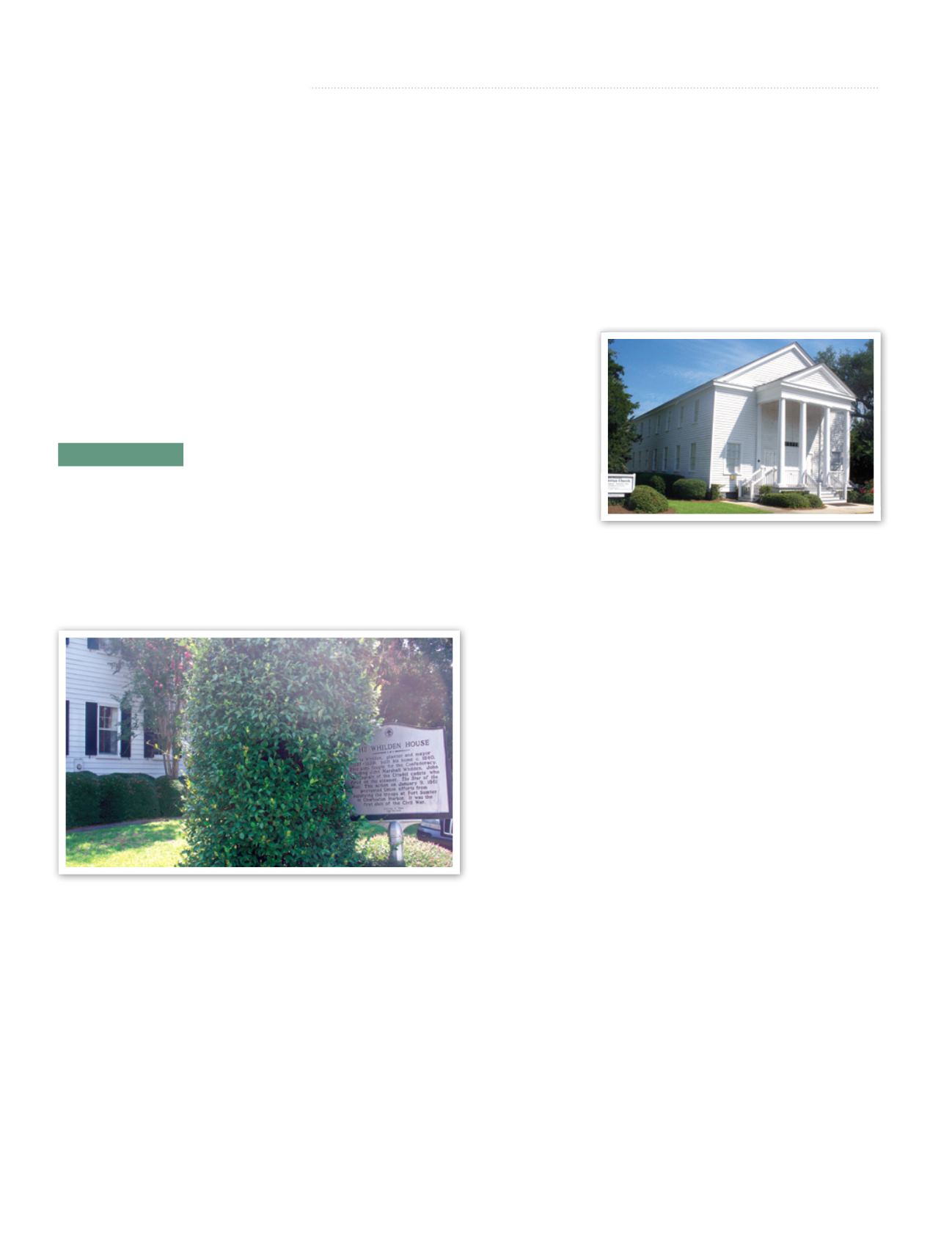

Major john Marshall Whilden
- “The Boy Major”
John Marshall Whilden was one of five brothers who
fought for the Confederacy; all were the sons of Elias
Whilden, Mount Pleasant intendant (mayor) from 1857
to 1858 and whose stately home still
stands at 226 Bennett St. He was a
member of the Citadel Class of 1864 and the gun com-
mander of #1 Gun Battery stationed on Morris Island,
which fired on the Union “Star of the West” in 1861 while
it was attempting to supply Union troops on Fort Sumter.
This was the shot that began the Civil War.
At the age of 23, Whilden was promoted to major and
in charge of the Coast Rangers of the 23rd South Carolina
Infantry at the Second Battle of Manassas in Virginia. He
personally led his regiment on four charges and was killed
in action on Aug. 30, 1862, still carrying the battle flag.
When federal troops occupied Charleston and the
surrounded the area, the Whilden home served as Union
headquarters. Another brother also was killed in the war;
the two of them were among approximately 17,000 South
Carolina men lost fighting for the Confederacy.
Cornelia hanCoCk
Born a Quaker in 1840 in Hancock’s Bridge, New
Jersey, Cornelia Hancock was a woman ahead of her time.
During the Civil War, she accompanied her brother-in-law,
a doctor, to the
Gettysburg bat-
tlefield, where
she volunteered
as a Union
Army nurse but
was rejected
by Dorothea
Dix because of
her youth and
good looks.
Undaunted, she persevered and served both at Gettysburg
and Petersburg.
Following the war, Hancock was sent to Mount Pleasant
as a missionary by the Philadelphia Friends Association for
the Aid and Elevation of Freedmen. She established a school
for 50 children of former slaves in the old Presbyterian
Church, which she described as “dilapidated.”
She later moved into a home in the village that was large
enough to act as both a school and her residence. While still
under federal rule, the town donated a lot on which to build
a two-story schoolhouse at the corner of King and Com-
mon streets. The school, built with funds from the Freed-
man’s Bureau, was named for Henry Laing of Philadelphia,
who provided money to support the school. For the next
10 years, Cornelia served as Laing School principal before
returning to Philadelphia, where she helped create the So-
ciety for Organizing Charity and the Children’s Aid Society
of Pennsylvania. She died in Atlantic City, New Jersey, in
1927, at the age of 87.
In 1940, the Laing School became part of the public school
system, the first accredited black school in South Carolina.
In her letters, published in 1965, Cornelia expressed
her contempt for the former rebels: “I would like to …
put all the Secesh (Secessionists) in the poorhouse and
keep them there till they die.” Her mother cautioned her
to be “more prudent.”
Carlyle MCkinley
While still in his early teens, Carlyle McKinley fought
for the Confederate cause in the defense of Atlanta. Born
by pam gabriel
www.mountpleasant.menu |
www. readmpm.com|
www. ilovemountpleasant.com50
Following the Civil War, Christ Church Parish and the small Village of Mount Pleasant lay in ruins. With no slave
workforce, the large plantations were deserted. The summer homes of the wealthy in the Village were abandoned. The
remaining residents farmed, fished and shrimped to survive. Small businesses were established and slowly the town
thrived. The biggest change came following the opening of the Cooper River Bridge in 1929. Residents turned to
catering to the tourists who passed through town on their way to Sullivan’s Island and the Isle of Palms.
–The Editors
Influential Icons
When federal troops occupied the area around Charleston, the
Whilden home served as Union headquarters.
Cornelia Hancock established a school for the children
of former slaves in the old presbyterian Church.
The second in a series
.MountPleasant. enu |
.ReadMPM.co|
.ILoveMountPleasant.co















